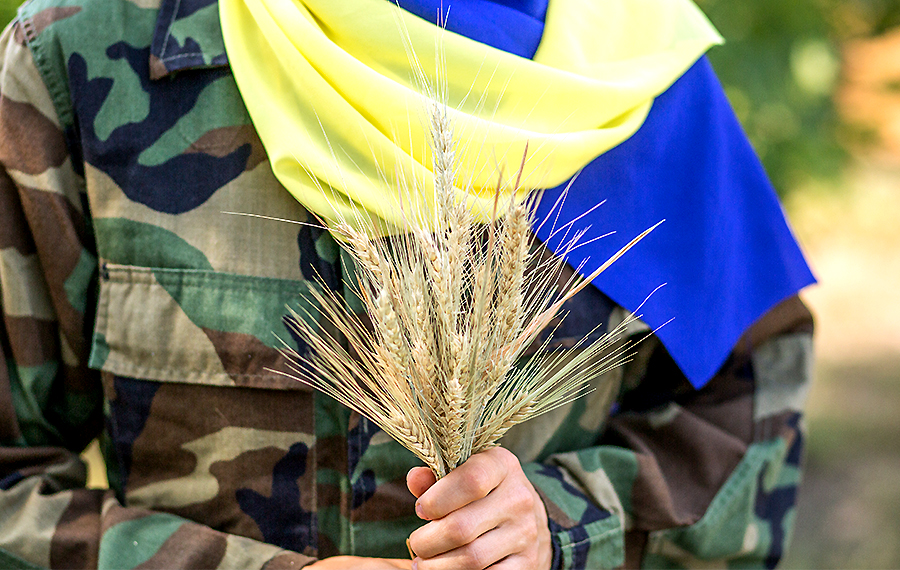
Even under the conditions of martial law, taking into account possible insufficient planting and a decline in agricultural technology, Ukraine is capable of meeting its food needs. The main risks are related to the unpredictability of events regarding Russian aggression and the violation of Ukraine's territorial integrity. The sowing campaign has become the country's second front.
Ukrainian agricultural production is concentrated on more than 30 million hectares of arable land. This allows the country to be fully supplied with food and have a significant surplus for export. In addition, the available stocks of grains and vegetable oils cover two years of domestic needs, according to the Ministry of Agrarian Policy. It is food surplus “locked” by the war in Ukraine and the lack of opportunities to export that make a global food crisis inevitable.
‘When the global food crisis unfolds, Ukraine will suffer less, though it may seem strange in war conditions. The country has a sufficient amount of grains for domestic needs and has a non-exportable surplus. We are trying to export corn and sunflower oil — surpluses exceed annual consumption. There are 6 million tons of wheat, the government has banned its export, and the mentioned volume theoretically covers fully the needs of the next season. Winter wheat was seeded in the fall and will be harvested,’ Maria Kolesnyk, deputy director of ProAgro Group said.
The Ukrainian AgrariCouncil (UAC) Deputy Chairman Denys Marchuk supports the opinion. ‘Ukraine has excess food stocks, but the world is threatened with a crisis due to the inability to import grains and vegetable oils in sufficient quantities,’ Denys Marchuk said.
The relevant ministry assures that Ukraine will be able to feed itself, and reports on the beginning of the spring sowing season: as of March 25, 150 thousand hectares of spring crops were sown — corn, soybeans, sunflowers, millet, buckwheat, oats and sugar beets. Ukraine has sown about 15 million hectares of traditional spring crops. What will the sowing area be this year? This question remains open, because farmers are sowing in the immediate vicinity of the shelling. In the current conditions it is very hard to carry out a sowing campaign, sometimes it is simply impossible. Sometimes farmers have to rearrange crop rotation on the go based on the availability of seeds, fertilizers and access to water. The predicted growth of demand for cereals and legumes also prompts to field rearrangement.
No irrigation — no corn to sow
Agrarians of the occupied districts of Kherson region have found themselves in a difficult situation. The agricultural enterprise Alfa-Agro in Chaplinsky district was planning to start sowing. Everything was ready for it: machinery, seeds, people. But when the agronomist and security officer were driving round the fields, they met a patrol of occupants, who said the fields were mined and, therefore, they had to stay at home and keep their heads down. Besides, there is an acute issue of irrigation in the south. Alfa-Agro is cultivating 1,750 hectares, of which 1,400 hectares are under watering and 38 hectares are under drip irrigation.
‘I foresee several scenarios of production. The first one is the availability of irrigation. For me it is the most important factor, because soybeans and corn do not grow on our fields without irrigation, so I have decided that I will wait until the last moment, until I understand that irrigation systems work. If I see they do not work, I will urgently replace the available seed with sunflower seed, though I gave up that crop several years ago. What can I do? Sunflowers will grow without irrigation unlike soybeans and corn. So the first scenario is optimistic. There are several more scenarios, depending on when the irrigation system will be activated and whether it will start at all. Seeding terms may be shifted, with late soybeans dropping out of the crop rotation. Another option: we will not sow corn, only soybeans, perhaps we will add sunflowers to this crop rotation. If there is an opportunity to activate irrigation, even late, we will sow ultra-early soybean varieties in June,’ Igor Braginets, head of the farm, said.
According to his conclusions, the prospects for the new irrigation season are rather vague. The whole system is under occupation. Both the Kakhovka main canal and the main pumping station have been seized. There are a lot of questions: who will supply power to these facilities, how will water be distributed, with whom should we sign agreements, who will take responsibility for water supply, will the farmers want to cooperate with the occupants and subjected to the law of collaborators?
Corn sales are questionable while the demand for cereals is growing
In Kharkiv region, Izium, Balakleya, part of Chuguiv region, Burluk, Volchansk and Kupyansk are in the zone of active combat operations. A significant part of farms’ facilities — machine yards, grain elevators, warehouses and offices — were destroyed in areas of fire resistance.
In regions occupied without fighting farmers are waiting for the right moment to sow, because they believe they will harvest crops in the liberated territories. Yurii Mykhailov, head of a farm in Kharkiv region, said that the occupants have seized all his facilities in Izium, including farm machinery and products remains. There are no prospects for sowing in this area, because it is the center of hostilities and there is live fire. However, in areas under Ukrainian control field works are in full swing.
Yurii Mykhailov says about half of farmers in Kharkiv region will be able to sow on time. Opportunities for field work are determined by the course of hostilities and logistics. The whole campaign is a total risk. Farmers are also considering which crops to plant under martial law. ‘We are faced with a choice: does it make sense to sow corn if its sales are in question? Apparently, we will increase the area under cereal crops at the expense of corn due to the growth of domestic demand for cereals,’ Yurii Mykhailov said.
The demand for peas and lentils will also increase in the domestic market. We can expect growth of areas under legumes, which are early-ripening crops. They allow quickly feed the country with vegetable protein and improving soil conditions.
‘Growing peas makes it possible to produce crops with little or no fertilizers. The crop is valuable in terms of protein content, which is important under the threat of a food crisis. Lentils are an interesting crop in this sense as well. At the same time, legumes are good precursors of cereals, as they are an additional source of nitrogen in the soil. Moreover, in conditions of seed shortage, commercial varieties of peas with a certain treatment can be used as seed material,’ Oleksandr Goncharov, candidate of biological sciences and agronomy expert, said.
The UAC also confirms the trend. ‘Agrarians dispose themselves to sow more peas and cereal crops this season,’ Denys Marchuk emphasized.
A sowing campaign will be carried out, but there is still a risk of insufficient planting in the combat areas. The transition to extensive technologies due to the lack of fuel, fertilizers, PPPs and operating assets will lead to crop yields reduction. Ukraine is likely to meet its consumption needs. Will there be a surplus of grain for export in the new season?
Monday, 28 March 2022